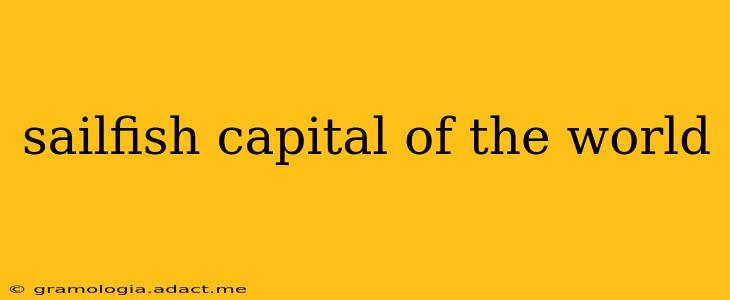Stuart, Florida, proudly claims the title of "Sailfish Capital of the World." But what makes this charming coastal town so uniquely associated with these magnificent marine creatures? This isn't just a catchy slogan; it's a testament to Stuart's rich history, thriving ecosystem, and dedication to conservation. Let's dive deep into what makes Stuart the undisputed king of the sailfish realm.
Why is Stuart, Florida, the Sailfish Capital of the World?
Stuart's claim to fame rests on its exceptional location within the confluence of the Gulf Stream and the warm waters of the Atlantic Ocean. This unique geographical position creates a rich feeding ground for baitfish, attracting massive schools of sailfish in pursuit of their prey. The abundance and accessibility of these majestic fish have made Stuart a world-renowned destination for anglers seeking the thrill of a lifetime. Generations of skilled anglers have perfected their techniques in these waters, further solidifying Stuart's reputation.
What makes Stuart's sailfish population so significant?
The sheer number of sailfish that congregate off the coast of Stuart is astounding. These graceful predators, known for their impressive dorsal fins and powerful builds, are drawn to the area's plentiful food sources. This concentration creates an unparalleled opportunity for both recreational and scientific study of the species, contributing significantly to our understanding of sailfish behavior and conservation needs.
What is the best time to see sailfish in Stuart?
The peak season for sailfish in Stuart typically runs from November through April. During these months, the waters are ideal for both sailfish and the baitfish they feed on. The cooler temperatures and increased upwellings further contribute to the concentration of fish in the area. This time period is when you'll find the highest density of sailfish and the best chances for a memorable fishing experience.
What are the most popular fishing techniques for sailfish in Stuart?
Sailfish in Stuart are typically caught using trolling techniques. This involves trailing lures or live bait behind a moving boat, mimicking the natural movement of prey. Experienced captains and guides in the area are highly skilled in locating schools of sailfish and utilizing the most effective trolling methods to increase the chances of a successful catch.
Are there any conservation efforts to protect sailfish in Stuart?
Absolutely! Stuart's commitment to sailfish extends beyond just fishing. The community recognizes the importance of responsible angling practices and actively supports conservation initiatives aimed at protecting the sailfish population. This commitment involves advocating for sustainable fishing regulations, promoting catch-and-release practices, and educating the public about the importance of preserving this magnificent species. Several local organizations actively participate in research and conservation efforts, working to ensure the long-term health of the sailfish population.
How can I experience sailfish in Stuart without fishing?
While fishing is a major draw, there are other ways to appreciate the sailfish population in Stuart. Whale watching tours frequently spot sailfish alongside other marine life. You can also visit local museums and marine centers to learn more about the sailfish and the local ecosystem. Additionally, observing from the shore can also provide a glimpse of these incredible creatures, though sightings are less frequent than out on the water.
Conclusion: More Than Just a Title
Stuart, Florida's claim as the "Sailfish Capital of the World" isn't merely a marketing tagline; it’s a well-earned title reflecting the area’s unique ecological characteristics, the dedication of its anglers, and a deep commitment to conservation. Whether you're an avid angler or simply appreciate the beauty of these magnificent creatures, Stuart offers a unique and unforgettable experience. The town's dedication to responsible stewardship ensures that future generations will continue to marvel at the graceful power of the sailfish in their natural habitat.
